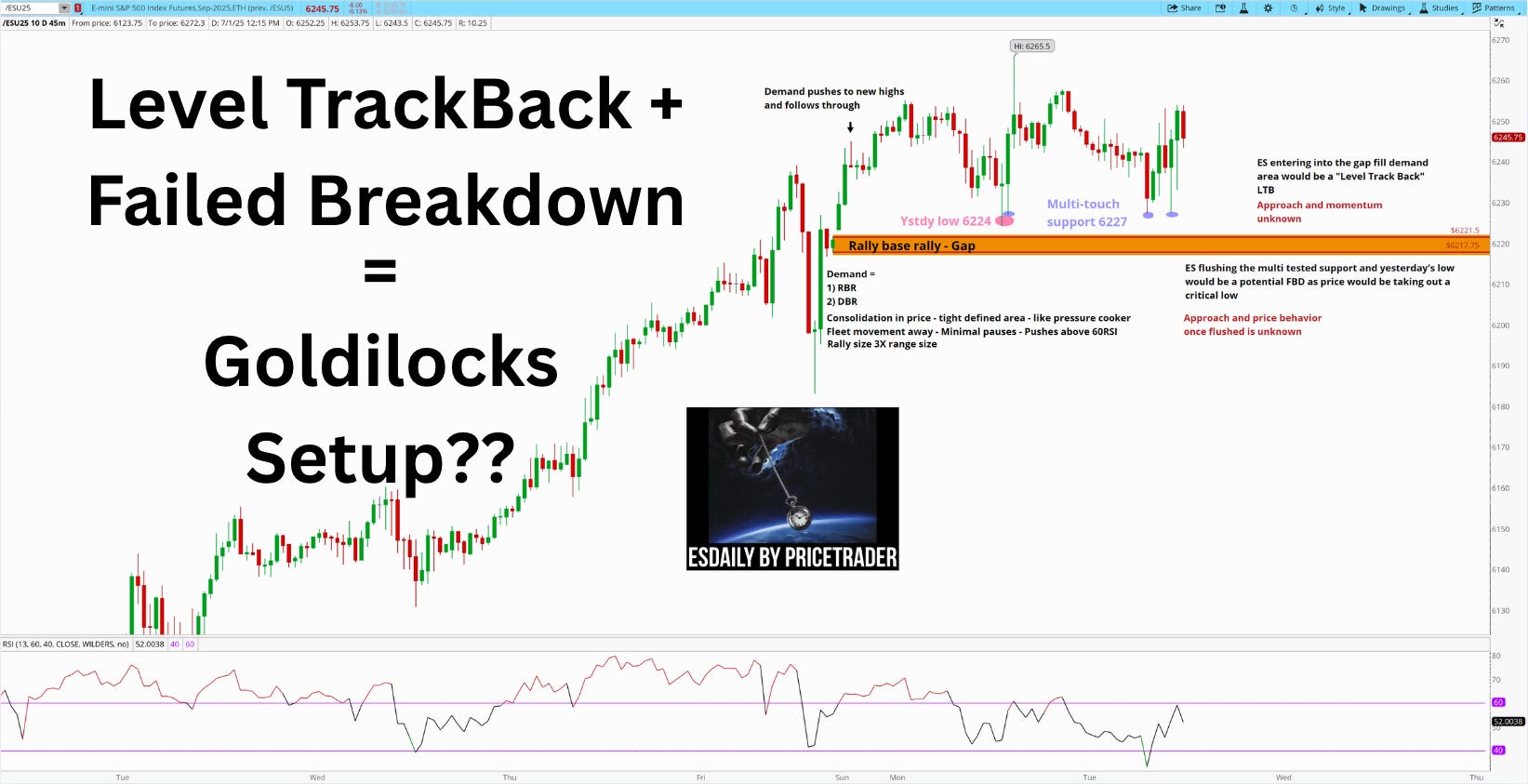When Traps and Trackbacks Collide: A+ Long Setup Explained
How a fake breakdown into a proven demand zone creates one of the cleanest risk-reward trades on the board — if you know what to look for. Read on browser - Not Phone
I talk about failed breakdowns and level trackbacks all the time.
Not because they’re trendy.
Not because they’re fancy.
But because they work.
They’re the cleanest visual representations of real opportunity on a chart.
No need for headlines. No need for VWAP, order flow, or drawing 16 boxes on a 5-minute candle.
Price is just emotion — fear and greed — painted in red and green.
Learn to read it.
Match it with momentum.
That’s the game.
And sometimes, the two best setups — the failed breakdown and the level trackback — show up at the exact same spot.
When that happens?
You get a high-probability trap… right on top of a proven demand zone.
Let me show you what that looks like.
I’ll walk you through each step of the chart below:
(I’ve widened it to display larger than normal: best used on desktop browser)
Price recently shot up from a spot on the chart around 6221 to 6217. That move created what we call a “demand zone” — it’s like a launchpad where buyers stepped in and shoved price higher.
The tight consolidation builds up pressure much like a pressure cooker - When ES leaves the area, the move is fleeting away.
There’s no hesitation and the range of the move is much larger than the compression area that created a new high. These distinctions are important.
If price comes back down there, it might use the same demand to fill additional orders - I. E. bounce again.
We call that a Level Trackback, or LTB for short.
Basically: price is just coming back to visit the place where the big buyers showed up before.
Now look right above that zone. See how price bounced off 6227 and 6224 a few times? That means it’s acting like a floor — buyers keep stepping in there. If price falls below those levels, it’ll look like the floor is breaking.
That tricks some traders into going short (betting price will drop), but often times it setup as a bear trap. We see the increased volatility of taking out a critical low as an opportunity for liquidity. If this happens we’ll see acceptance below the flushed area.
If price find a floor, builds momentum, and reclaims the initial flush point back above:
That’s what we call a Failed Breakdown (FBD).
It means the drop was a fakeout — just enough to trap some sellers before flipping higher.
So this setup is potentially juicy because you’ve got two big things happening together:
1) Price coming back to an old demand zone (LTB).
2) Price possibly faking a breakdown below support (FBD).
And here’s what makes it even better: before this, price had been squeezing into a tight range — like a coiled spring. That tight consolidation shows energy building. If that spring unloads straight into the demand zone and then bounces? Boom — classic wipsaw and shakeout.
That’s a potential trade. The same one larger orders can be filled.
LBT + FBD is like a traders superpower brining together two proven setups.
But…
You don’t just buy because it touches the zone though.
You wait for it to flush below support, hit the demand area, and then watch to see if it starts bouncing. You want to see price snap back above 6224 — that tells you the trap worked - That’s there’s true buyers and demand.
If it does, and RSI looks good (above 40 is fine), that’s a green light.
But if price just bleeds lower slowly or starts building red candles over and over, you stay out — that’s not the setup. We don’t buy stairsteps down. You want the flush, the trap, and the reclaim.
That’s when this combo works best.
🧠 Important Note:
If there’s one thing that stop this from being a Goldilocks ’ setup it’s this:
This setup forms near the top of a recent bounce, not deep into a flush.
That matters.
Why?
Because price is still sitting relatively high on the curve — meaning it hasn’t fully explored the downside yet. True liquidity-seeking behavior often pushes price deeper, breaching even strong-looking support.
That’s exactly why we don’t blindly buy just because price tags a level.
You wait for signs that the trap is set — a flush, a reclaim, a momentum shift.
Only then do you act. Not before.
-Cheers
PriceTrader
P.S.
Setups like this come rarely - Normally, just a few a day is all ES provides us with. But we find them, publish them, and talk about the setups live as they unfold.
Subscribe to receive the setups that matter - Ignore the ones that don’t



